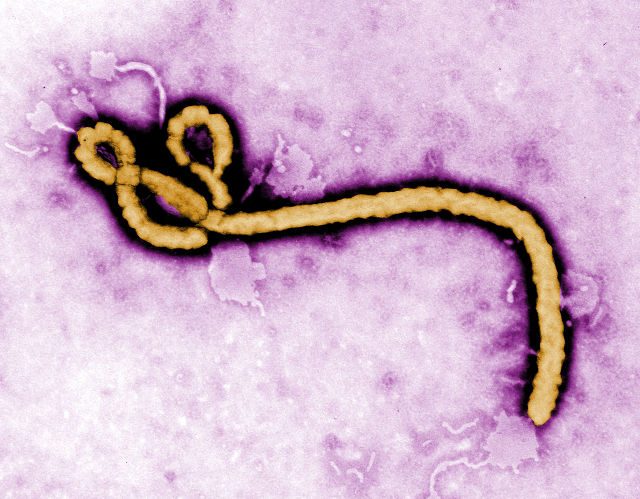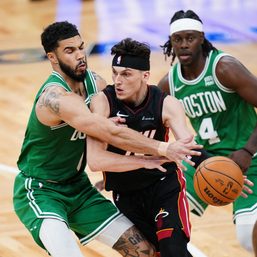SUMMARY
This is AI generated summarization, which may have errors. For context, always refer to the full article.

PARIS, France – As the deadliest Ebola outbreak in history tightens its grip on West Africa, the quest for a treatment or vaccine is gaining urgency.
Several experimental drugs exist, but none have been licensed for human use.
According to University of Oxford epidemiologist Oliver Brady, up to 30,000 people would have required a treatment or vaccine since the beginning of the outbreak to August 20, had the drugs been available.
Last week, scientists tracking Ebola’s spread released 99 sequenced genomes of the hemorrhagic virus in the hopes it may help the hunt for a treatment.
These are some of the candidate drugs.
Treatment: Of several prototypes in the pipeline, one dubbed ZMapp has been fast-tracked for use in the outbreak.
ZMapp: A cocktail of three antibodies that cling to the virus and inhibit its reproduction, ZMapp is developed by Mapp Biopharmaceutical in California, in conjunction with the US Army.
Last Friday, scientists reported that 18 macaque monkeys given high Ebola virus doses recovered fully after being treated with ZMapp.
Although the monkeys had been given a different strain, lab-dish tests indicated the drug could also inhibit the strain that has killed more than 1,552 people and infected 3,000 infected in Guinea, Sierra Leone, Liberia and Nigeria, according to the World Health Organization’s (WHO) latest toll.
Since the WHO gave the green light on August 12 for experimental treatment to be used in the Ebola crisis, ZMapp has been given to seven infected frontline workers.
Of those cases, two American doctors recovered, while a Liberian doctor and a Spanish priest died. A doctor and a nurse, both Liberian, and a British nurse flown to London from Sierra Leone, are still in treatment.
Stocks of ZMapp, which is derived from tobacco leaves and is difficult to produce on a large scale, are exhausted, its manufacturer said on August 12.
Anthony Fauci, director of the US National Institute for Allergy and Infectious Diseases (NIAID), said it would likely take several months “to get even a modest amount” of ZMapp.
TKM-Ebola: A drug that kills virus-infected cells, is being developed by Vancouver-based Tekmira Pharmaceuticals under a $140-million (105-million-euro) contract with the Pentagon.
In tests on a small group of monkeys, it provided 100 percent protection against an otherwise lethal dose of Ebola virus.
It is in a Phase I trial, the first of a 3-step vetting process, to test its safety in non-infected humans. On August 14, the company said it was in contact with government agencies, NGOs and the WHO “on the potential use” of TKM-Ebola in west Africa.
Anti-viral drugs: Several proposed Ebola treatments started out as influenza drugs.
Avigan, a tablet developed by Fujifilm Holdings was approved in Japan in March and is undergoing clinical trials in the United States. Japan has said it is ready to ship the drug to Ebola-hit areas, although no Ebola-specific tests have been conducted in lab animals or humans to show its efficacy.
North Carolina-based BioCryst Pharmaceuticals said last week it had received $2.4 million (1.8 million euros) from NIAID to test the efficacy in primates of its BCX4430 antiviral as a treatment for Ebola. The study should start “within weeks”.
Vaccines: There are two main candidates, but both face extensive trials and neither is likely to be available before 2015 even if they are fast-tracked.
British company GlaxoSmithKline (GSK) has said a prototype vaccine may enter early-phase human volunteers “later this year.”
The formula comprises an adenovirus — a virus group best known for causing the common cold — into which two Ebola genes have been slotted.
The virus penetrates a cell and where it triggers an immune response to recognise and destroy an invading virus, but without replicating the Ebola genes.
The other is a vaccine by Johnson & Johnson subsidiary Crucell, which was shown to “completely protect monkeys” in lab tests with a single dose.
A human trial found the drug was safe. A further Phase I trial is planned for late 2015 or early 2016. – Rappler.com
SOURCES:
http://www.nature.com/news/scale-up-the-supply-of-experimental-ebola-drugs-1.15736
http://www.gsk.com/en-gb/our-stories/health-for-all/our-contribution-to-the-fight-against-ebola/
http://www.niaid.nih.gov/topics/ebolamarburg/research/pages/default.aspx
http://www.crucell.com/R_and_D-Clinical_Development-Ebola_Vaccine
http://investor.shareholder.com/biocryst/releasedetail.cfm?ReleaseID=868302
Add a comment
How does this make you feel?





There are no comments yet. Add your comment to start the conversation.